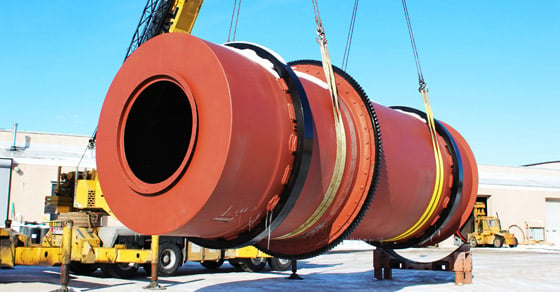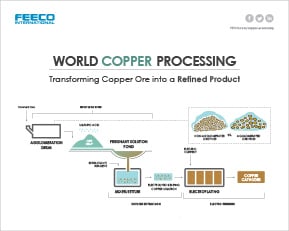Copper is a versatile metal used in many of the products that modern civilization relies on, from electronics to infrastructure. For decades, smelting has been the primary approach to copper extraction. Although this method has proven to be effective for high grade sulfide ores, it has not been an option for other ore types, namely oxide ores and low grade sulfide ores.
A process growing in popularity, however, has opened up new opportunities for the processing of both of these ore types: Solvent Extraction Electrowinning.
Solvent Extraction Electrowinning (SX-EW), also sometimes referred to as Leach Solvent Extraction Electrowinning (L-SX-EW) for its convergence with the heap leaching process, is a processing method whereby copper can be extracted from ores through hydrometallurgical means.
The effectiveness of this process is further increased with the addition of an agglomeration step prior to heap leaching. FEECO provides custom agglomeration drums (agglomerators) and material handling equipment for the heap leaching component of the SX-EW process.
How SX-EW Works
Solvent extraction electrowinning is a complex process of chemical reactions, but can be simplified into three main steps:
Heap Leaching Copper Ore with Agglomeration
Crushed copper ore is first typically processed via heap leaching. An effective leaching step is critical to SX-EW, as it sets the stage for how much copper can be recovered. For this reason, the heap leaching step is commonly preceded by agglomeration of the ore in a rotary drum agglomerator. This offers significant benefits, ultimately yielding improved recovery rates.
Agglomeration greatly improves the leaching process by “binding” fines so that they do not impede percolation of the leachate through the ore pile. Ore that has been agglomerated is more uniform in size and shape, which maximizes the ability of the leachate solution to percolate through the channels between particles in the ore heap.
Agglomeration of the ore fines is carried out by tumbling the crushed ore fines in a rotating drum. Here, the leachate solution, sulfuric acid in this case, can be added into the agglomeration drum. The tumbling action mixes the ore with the leachate solution to create a homogeneous mixture. The opportunity to add the leachate solution to the ore during agglomeration also offers the benefit of beginning the leaching process prior to the heap, further increasing efficiency.

Image: At left, non-agglomerated ore fines clog channels, impeding leachate percolation. At right, agglomerated ore fines allow more even and effective percolation of the leachate through the heap.
After agglomeration, the agglomerated ore is piled into heaps, which are then irrigated with sulfuric acid. The sulfuric acid used is often a recycled by-product of the copper smelting process. Through chemical reaction, the copper is dissolved into the sulfuric acid. The solution percolates through the heap, draining as a pregnant leach solution from which the copper can then be extracted.
Solvent Extraction
The copper solution resulting from heap leaching still contains impurities that must be removed before a pure copper product can be produced. For this, an extractant is needed.
The process of extracting the copper from the solvent is typically carried out in mixer-settlers which use different types of extractants to purify the copper in two stages.
The result is high grade, electrolyte-bearing copper.
Electrowinning
Electrowinning copper from the electrolyte is done through a process known as electroplating. This process utilizes an electric current to essentially pull copper ions from the extractant solution, “growing” or depositing them onto a sheet of metal, creating high purity copper cathodes ready for market.
Click the image below to view the infographic on copper refining >>
Benefits of SX-EW
Interest in SX-EW has grown exponentially in the past few decades, owing much credit to advancements in extractants (reagents) that have made the process increasingly viable and effective. The benefits of utilizing the SX-EW process are many:
Significantly Less Capital Cost
One of the main attractions to the SX-EW process is that it requires significantly less capital cost than a traditional smelting operation.
Opportunity for New Ore Bodies
Smelting operations are only economically feasible at large scale, subsequently causing ore bodies that would only require a small-scale facility to be neglected.
Conversely, SX-EW is economic at small scale, opening up new opportunities for smaller, but still valuable ore bodies to be economically processed.
Additionally, while smelting is only economically viable for processing higher grade sulfide ores, SX-EW can be used for oxide ores, as well as low grade sulfide ores. Until the advent of SX-EW, there were no economically viable options for processing low grade sulfide ores or oxide ores. However, these sources still represent significant amounts of untapped copper resources; in 2014, 16% of total copper production was recovered via SX-EW.
High-grade copper ores are becoming a thing of the past, with most ore falling in the range of .5% – 2%. Even deposits now considered to be high grade must still first be concentrated for smelting. This will likely further increase the importance of the SX-EW process in future copper production.
In addition to ore deposits, SX-EW has become a viable means of processing tailing piles, which were previously considered a waste because the ore in them was either too low grade to be worth processing, or because it had since oxidized.
Reduced Environmental Impact
Not only does SX-EW make use of what would otherwise have been considered a waste, but the process itself also offers lower impact on the environment when compared to traditional smelting methods.
Conclusion
Copper is a key component in upholding the needs of modern civilization. As sustainability becomes increasingly important, advances in technologies to minimize waste and environmental impact, while maximizing recovery rates, will become ever critical.
The Solvent Extraction Electrowinning (SX-EW) process offers a cost-effective, low impact way to process previously unprocessable or uneconomic deposits of copper. Combined with heap leaching and agglomeration, the effectiveness of this process is further increased.
While the SX-EW process has its roots in copper and is most well-known in this sector, its significant cost savings and efficiency is pushing it into other markets as well, including cobalt, nickel, zinc, and uranium.
FEECO has been serving the needs of the mining industry since 1951 with our custom, heavy-duty agglomeration drums. Many of the world’s top mining companies rely on FEECO agglomeration drums and material handling equipment to carry out the agglomeration step in the leaching component of their SX-EW operations.
For more information, contact us today!




